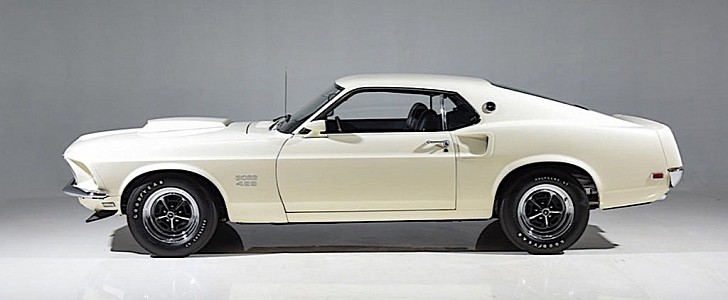There are tons and tons of impressive Mustangs out there, and the ones of the olden days will probably forever have a big say on the collector market. However, few of them are as coveted as the Boss 429.
With just a small number of them ever made (1,359) over a period of just two years (1969 and 1970), all resulting from Ford’s need to homologate the 429 semi-hemispherical engine for the requirements of NASCAR racing, the line is incredibly rare, mechanically impressive, and of course at times incredibly expensive.
A few of these 429s are rotating in and out of auction listings, changing hands repeatedly as their owners are gunning for profit. The 1969 example we have here is the latest to come out in the open and just got listed by Barrett-Jackson for the auction it has scheduled next month in Las Vegas.
We’re looking at a Wimbledon White example with no visible changes, the result of an older restoration. The interior, coming in black, is said to be all original, and that should make for yet another big plus in the eyes of the owner.
The Magnum 500 wheels wrapped in Goodyear Polyglass GT Tires get their spin courtesy of the engine that gives the car its name, “an early NASCAR 820-S” 429ci (7.0-liter) V8 ran through a 4-speed manual transmission.
The drivetrain is completed by a 3.91 positraction, differential, and power steering, and the entire machine rests on new springs and shocks.
According to the auction house, this Boss 429 is Kar Kraft model number 1404. It is offered with the original build sheet, dealer invoice, owner's manuals, service manuals, and a Marti Report. No estimate of how much it is expected to fetch is made, but we expect it to make a splash, as these cars usually do.
A few of these 429s are rotating in and out of auction listings, changing hands repeatedly as their owners are gunning for profit. The 1969 example we have here is the latest to come out in the open and just got listed by Barrett-Jackson for the auction it has scheduled next month in Las Vegas.
We’re looking at a Wimbledon White example with no visible changes, the result of an older restoration. The interior, coming in black, is said to be all original, and that should make for yet another big plus in the eyes of the owner.
The Magnum 500 wheels wrapped in Goodyear Polyglass GT Tires get their spin courtesy of the engine that gives the car its name, “an early NASCAR 820-S” 429ci (7.0-liter) V8 ran through a 4-speed manual transmission.
The drivetrain is completed by a 3.91 positraction, differential, and power steering, and the entire machine rests on new springs and shocks.
According to the auction house, this Boss 429 is Kar Kraft model number 1404. It is offered with the original build sheet, dealer invoice, owner's manuals, service manuals, and a Marti Report. No estimate of how much it is expected to fetch is made, but we expect it to make a splash, as these cars usually do.









